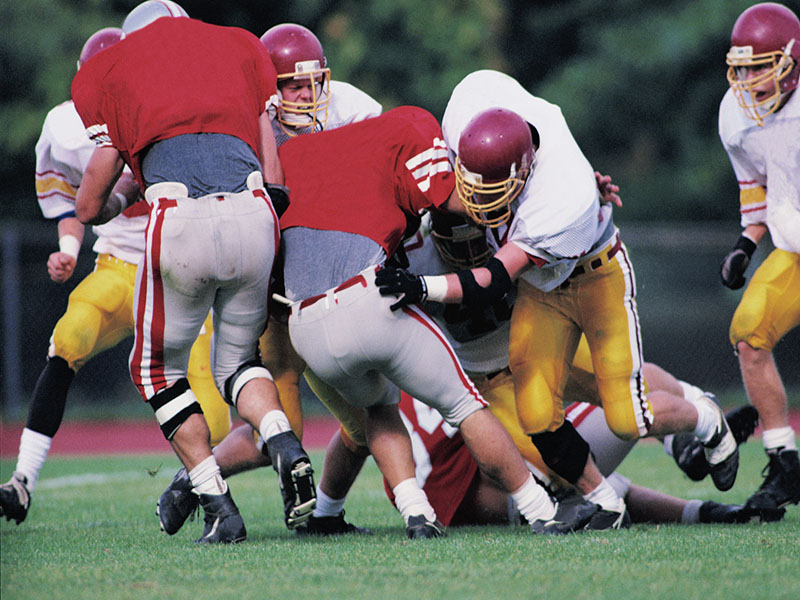
Friday, August 26, 2016

FRIDAY, Aug. 26, 2016 (HealthDay News) -- As college football players trade in their beach towels for helmets and padding, new research shows their risk of developing sports-related heat illness shoots up.
In particular, during the first 14 days of preseason play these athletes face a greater than usual risk for a specific type of heat illness called exertional heat illness (EHI).
EHI is a serious and potentially life-threatening series of health complications that sometimes unfold when strenuous activity meets hot weather, the study authors said.
Catastrophic consequences from heat illness are avoidable with proper prevention, recognition and treatment, explained study co-author Michael Ferrara. He's dean of the College of Health and Human Services at the University of New Hampshire in Durham.
Ferrara says it's important that athletes be educated about the "signs and symptoms of heat illness, nutrition, rest and the proper method of re-hydration during post-practice sessions."
Intermittent rest periods are also critical, to allow athletes time to cool down and rehydrate, he added.
It's also important to have medical professionals (such as athletic trainers) on hand to quickly identify and treat any heat-related trouble, he added.
Ferrara highlighted a number of different EHI concerns.
One is exertional heat cramps, affecting the calf, quadriceps and hamstrings, and/or lower back or abdomen. Treatment involves stretching, fluids and cooling down.
Heat exhaustion may prompt a slightly above-normal temperature, alongside headaches, nausea and fatigue. Typically this calls for fluids, cooling down and a cessation of activity. This is different than heat stroke, when body temperature soars to 106 Fahrenheit or higher, according to the U.S. Centers for Disease Control and Prevention.
Heat-related fainting is another issue, he said.
Ferrara also pointed out that athletes can overdo it with fluids when trying to prevent heat illness. This excessive consumption of fluids is called exertional hyponatremia. It's a dangerous situation in which electrolyte levels drop too low.
EHI can also be deadly. Nearly 125 college football athletes between 1960 and 2009 have died due to EHI, the study authors noted.
The current investigation looked for heat illness among 366,000 cases of on-field play involving football players in the National Collegiate Athletic Association. The players were from 60 colleges and universities across five regions in the United States.
In all, more than 550 EHI cases were identified. The study authors said the risk for EHI was roughly 1.5 for every 1,000 NCAA football players. Three-quarters of the cases involved cramping, while a quarter involved a combination of heat exhaustion and/or heat-related fainting.
Researchers also looked at the impact of "wet bulb globe temperature" (WBGT). WBGT assesses temperature, humidity, wind speed, sun angle and cloud cover to tally not just heat exposure but the overall "heat stress" produced while playing in direct sunlight.
In the end, the study concluded that when WBGT climbs above 82 degrees, EHI risk goes up significantly. The researchers said that coaches and athletic trainers need to be particularly wary of elevated WBGT levels.
Another expert further pointed out that some players will have specific medical conditions that make them particularly vulnerable to EHI.
Sickle cell anemia, asthma and pre-existing heart conditions can increase EHI risk, noted David Csillan. He's co-chair of a task force that recently issued guidelines on preseason heat acclimatization for secondary school athletics.
Antidepressants and ADHD medications can also boost the risk for dehydration, he added.
"[And] many athletes report to preseason camp de-conditioned and acclimatized to cooler, facility-controlled environments," observed Csillan. He's also head athletic trainer at Ewing High School in Ewing, New Jersey. "As a result, the immediate introduction of heat and exercise places apparent stress to their body," he said.
Coaches and athletic trainers, he said, need to continuously monitor such issues. They also need to pay attention to the particular needs of even younger high school athletes whose developing bodies "don't adjust to environmental changes as well as adults."
The study was published recently in the Journal of Athletic Training.
SOURCE: Michael Ferrara, Ph.D., A.T.C., dean, College of Health and Human Services, University of New Hampshire, Durham; David Csillan, MS, A.T.C., co-chair, "Inter-association task force on preseason heat acclimatization guidelines for secondary school athletics," National Athletic Trainers' Association (co-sponsor), and head athletic trainer, Ewing High School, Ewing, New Jersey; August 2016 Journal of Athletic Training
HealthDay
Copyright (c) 2016 HealthDay. All rights reserved.
News stories are provided by HealthDay and do not reflect the views of MedlinePlus, the National Library of Medicine, the National Institutes of Health, the U.S. Department of Health and Human Services, or federal policy.
- More Health News on:
- College Health
- Heat Illness
- Sports Safety





























.png)











No hay comentarios:
Publicar un comentario